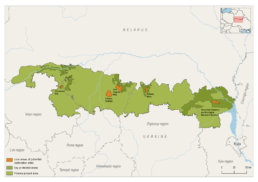Stary Zhadzien
This area is a vast and tapestry of forests and wetlands. At its heart lie the Stary Zhadzien and Vialikaje mires, two great peatlands separated by ancient sand dunes. Situated between the Almany Mires and the Pripyat National Park, this region collectively forms the largest complex of mires and forests in all of Europe.
The landscape is dominated by two key ecosystems: oligotrophic and mesotrophic bogs, and expansive pine and deciduous forests. The area’s hydrology is a unique blend of natural and historical features. An old network of canals, dug in the late 19th century, crisscrosses the land. Most of these have since been reclaimed by nature – overgrown with vegetation and dammed by beavers, with the water eventually finding its way into the Scviga River.
A near-total absence of roads and the seasonal waterlogging make this area virtually impenetrable to people. This very inaccessibility, however, is what makes it a critically important sanctuary for species that are highly sensitive to human activity and disturbance, such as the rare Greater Spotted Eagle.

Country: Belarus
Area: 17,048.4 ha
National protection status: Nature Reserve
International protection status: Ramsar site (2140) – Stary Zhaden (17,048.4 ha); Emerald Network* (BY0000051) – Stary Zhadzien (23,560.6 ha); IBA (BY039) – Stary Žadzien (16,285.0 ha).
* After denunciation of accession to the Bern Convention on the Conservation of European Wildlife and Natural Habitats, de jure there are no Emerald Network sites in Belarus.
Biodiversity and natural values

Habitats
The site is a large complex of forest and wetland habitats. About 10 habitats requiring specific protection under the Resolution No. 4 of the Standing Committee to the Bern Convention have been identified here, and this area is of particular importance for their conservation in Belarus.
Wetland Habitats
- Transitional mires and quaking bogs (7140),
- Raised bog complexes (7110),
- Beds of large sedges, usually without free-standing water;
Woodland Habitats
- Riverine ash-alder woods (91Е0),
- Sphagnum birch woods (91D0),
- Boreal coniferous bog woods and Nemoral coniferous bog woods (91D0);
Inland Dunes & Sparse Vegetation
- Inland sand dunes (2330).



Biodiversity
The site is a critical breeding area for globally threatened species, such as the Greater Spotted Eagle (Aquila clanga) (more than 3% of the national population). It is the breeding area for 2% of the national population of the Crane (Grus grus), the Great Grey Owl (Strix nebulosa), the White-tailed Eagle (Haliaeetus albicilla). The Black-tailed Godwit (Limosa limosa), the Eurasian Curlew (Numenius arquata), the Black Stork (Ciconia nigra) and the Short-toed Snake Eagle (Circaetus gallicus) have also been recorded breeding here.
The site is an important habitat for rare plant species, such as the Yellow Azalea (Rhododendron luteum) and the Sand Jurinea (Jurinea cyanoides). More than 30 species listed in the Resolution No. 6 of the Standing Committee to the Bern Convention have their habitat here.
The most important impacts and threats

Forest felling, dead wood removal

Illegal hunting

Old drainage systems
Conservation measures
About 72% of the area is protected within the national nature reserve, where drainage, construction, logging and some other land uses are restricted. Special protected areas have been established for some natural habitats and species. Existing conservation measures cover approximately 75% of the area.
Our activities in the area
Rare biotopes and habitats of species listed in the Red Data Book of Belarus were identified and put under protection. Fire-fighting equipment was purchased and handed over to the personnel of the reserve.



The project “Polesia – Wilderness Without Borders” is part of the Endangered Landscapes & Seascapes Programme and is funded by Arcadia. The project is coordinated by Frankfurt Zoological Society (FZS).

